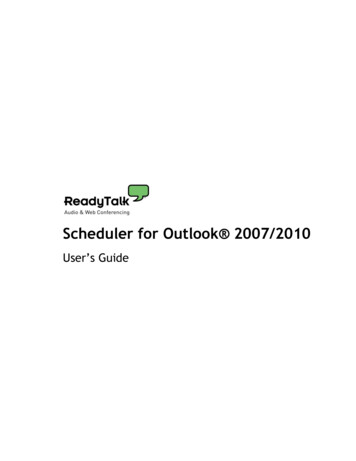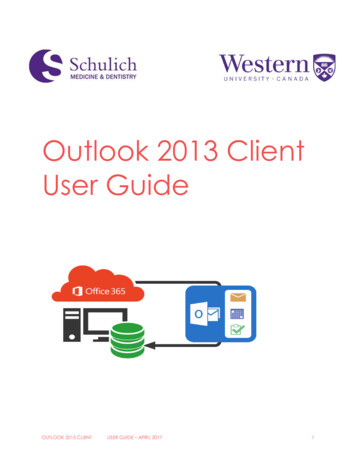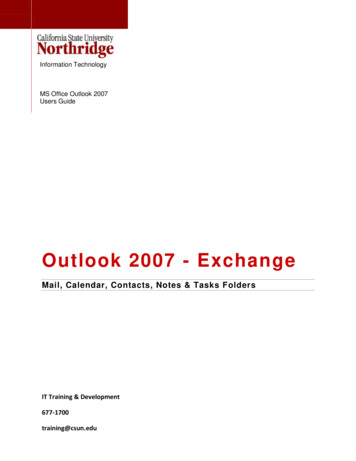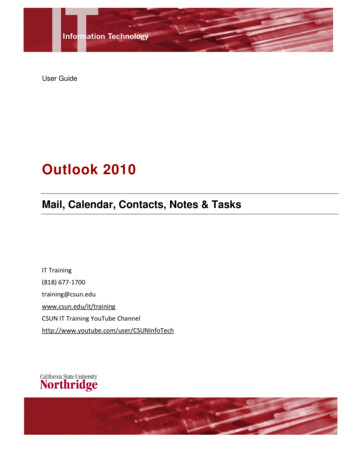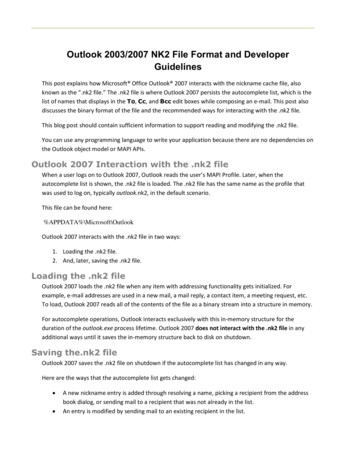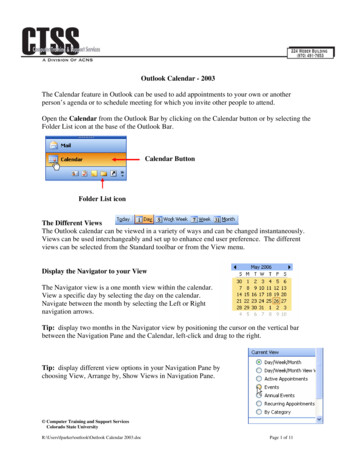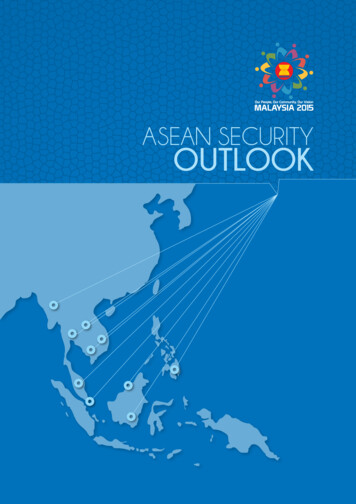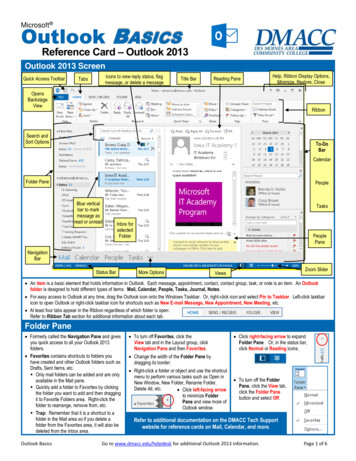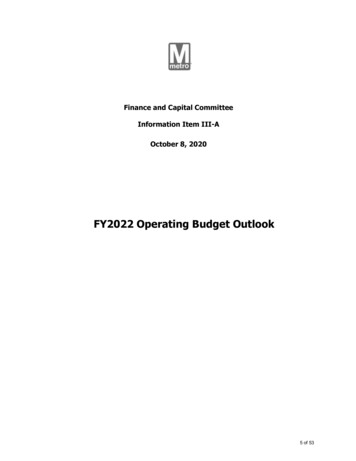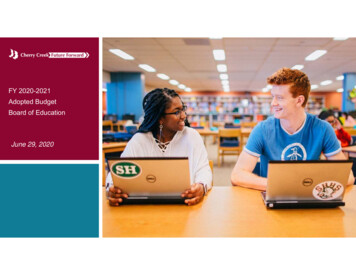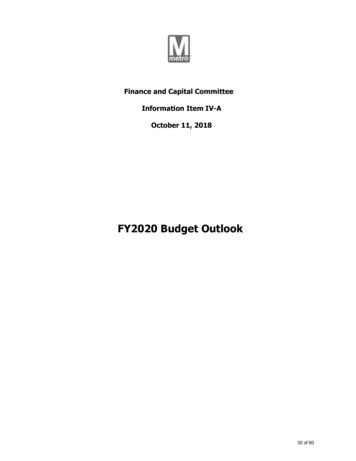
Transcription
Finance and Capital CommitteeInformation Item IV-AOctober 11, 2018FY2020 Budget Outlook35 of 60
Washington Metropolitan Area Transit AuthorityBoard Action/Information SummaryActionInformationMEAD Number:202029Resolution:YesNoTITLE:FY2020 Budget OutlookPRESENTATION SUMMARY:The presentation provides a preview of the FY2020 Operating Budget and FY20202025 Capital Improvement Program.PURPOSE:Management will present a preview of the FY2020 Operating Budget and FY20202025 Capital Improvement Program. Key elements will include:An update on Keeping Metro Safe, Reliable and Affordable (KMSRA)Operating and Capital Budget PrioritiesCapital and Operating Budget OverviewBoard Policy ConsiderationsScheduleDESCRIPTION:Key Highlights:The presentation begins with a review of progress to date on the GeneralManager/CEO's plan to Keep Metro Safe, Reliable and Affordable (KMSRA).Metro is ramping up to average capital investment of 1.5 billion annually, hasestablished a dedicated capital trust fund, exclusive to capital investment, andis limiting jurisdictional annual capital subsidy growth to three percent. Metrocontinues to encourage the U.S. Congress to reauthorize the Passenger RailInvestment and Improvement Act (PRIIA) beyond FY2020, which provides 150 million in annual federal funds match by 150 million provided by theDistrict of Columbia, State of Maryland, and Commonwealth of Virginia. Inorder to establish a sustainable operating model, Metro is limiting jurisdictionaloperating subsidy growth to three percent and deploying innovativecompetitive contracting. The items on the KMSRA agenda that remain to becompleted are amending the National Capital Area Interest ArbitrationStandards Act, restructuring retirement benefits, and creating a Rainy DayFund.36 of 60
The FY2020-2025 Capital Improvement Program prioritizes improvingcustomer service, fully funding system safety and compliance, continuing thefocus on system preservation and State of Good Repair, meeting programbudget and schedule, and developing a capital investment pipeline using theDevelopment and Evaluation (D&E) process.The FY2020 operating budget prioritizes increasing ridership, maximizingoperating efficiency, increasing non-fare revenues, and enhancing employeeengagement and development.Background and History:In April 2017, GM/CEO Paul Wiedefeld announced the plan to Keep MetroSafe, Reliable and Affordable (KMSRA). The plan calls for ten actions torestore the system to a state of good repair and establish long-term financialsustainability:Invest 15.5 billion over next 10 years for critical capital projects,increasing average annual investment to 1.5 billionEstablish a multi-year, inflation-adjusted stable revenue sourcegenerating 500 million per year to a Capital Trust FundDedicate the Capital Trust Fund exclusively to capital investment, notday-to-day operationsSecure Congressional reauthorization for federal capital investment(PRIIA) at least at current level of 1.5 billion over 10 yearsCap annual jurisdictional capital contribution growth at 3 percentCap annual jurisdictional operating contribution growth at 3 percentSupport flexibility to reduce cost through innovation and competitivecontracting, where effectiveAmend the National Capital Area Interest Arbitration Standards Act (WolfAct) to require consideration of WMATA’s financial conditionInitiate new retirement program for new hiresCreate a Rainy Day Fund to mitigate unforeseen obligationsIn response to the KMSRA plan, in April 2018, the legislatures of the District ofColumbia, Maryland and Virginia passed bills to provide a combined 500million in dedicated funding to Metro each year. The Governor of Maryland,Governor of Virginia and the Mayor of the District of Columbia have sincesigned each bill into law. The KMSRA plan now serves as the basis for thedevelopment of the Metro FY2020 Operating Budget and FY2020-2025 CapitalImprovement Program.Discussion:GM/CEO Budget GuidelinesThe General Manager (GM/CEO) has provided staff with a series of guidelinesfor the FY2020 budget development process, shown below:37 of 60
Safety trumps serviceNo service cutsNo fare increasesImprove customer service to grow ridershipAdditional management efficiencyInvest in employees today . for tomorrowUse flexibility provided by federal funding regulationsBuild capacity to deliver 1.5 billion average annual capital programExplore outsourcing where appropriateMeet legislative 3 percent subsidy capFY2020-2025 Capital Improvement ProgramThe presentation includes an overview of the Capital Program Planning andManagement process, including planning functions such as asset managementand needs prioritization, as well as program development and implementationactivities including Development and Evaluation, Project Development, andProject Implementation. The presentation then provides a series of examplesof projects that are underway, in development, and in the Development andEvaluation stages.FY2020 Operating PlanThe FY2020 Operating Plan begins with two key priorities: increasing ridershipand employee engagement. The plan is subject to Maryland and Virginiastatutes that limit growth to three percent. It begins with the FY2019 budgetand adds additional service and labor settlement committments that will add tothe FY2019 subsidy. With these additions, the FY2019 revised Base subsidyis 1.06 billion, of which three percent is 32 million. In considering theFY2020 budget, there are additional subsidy drivers that will exceed 32million. The combination of inflation and revenue losses from outages forsafety and State of Good Repair capital projects, for example, is 40 million.Additionally, the combined impact of Silver Line Phase 2, mandates from theOccupational Safety and Health Administration (OSHA), and ADA Paratransitservices, is more than 90 million.The following are key policy considerations for the Board to consider:FY2020-2025 Capital Improvement ProgramFlexible use of federal funds for preventive maintenanceFY2020 Operating BudgetWhich items are within or above 3 percent capCollective Bargaining Agreements (CBA) cost of 27 millionImpact of 23 million revenue loss due to major safety andstate of good repair capital projectsBudget, service reliability and safety implications of hours of serviceLack of contingency fund for emergencies and special events38 of 60
Long-term structural financial issues impact on FY2020 budget andbeyondPension - annual cost is 165 millionOPEB - annual cost is 45 millionBus Transformation ProjectFUNDING IMPACT:This is an information item previewing the GM/CEO’s proposed FY2020 budget.There is no immediate impact on funding.TIMELINE:June 2018 – Conclusion of FY2018Previous ActionsSeptember 2018 – Board approved Collective BargainingAgreements (CBAs) that followed the August 2018arbitration awardNovember 2018 – FY2020 Proposed Budget presented tothe BoardDecember/January 2019 – Board Budget DeliberationsAnticipated actionsafter presentationJanuary/February 2019 – Public Outreach and PublicComment PeriodMarch 2019 – FY2020 Budget AdoptionApril 2019 – Submit Federal Grant ApplicationsJuly 2019 – Fiscal Year 2020 BeginsRECOMMENDATION:This is an information item – no recommendation at this time. Budget adoption isscheduled for March 2019. Budget approval in March is necessary to ensureuninterrupted regional funding of the capital program and to allow for the timelyapplication and award of FTA grants.39 of 60
FY2020 Budget OutlookFinance & Capital CommitteeOctober 11, 201840 of 601WASHINGTON METROPOLITAN AREA TRANSIT AUTHORITY
Purpose Preview FY2020 Operating Budget and Capital Programo Keeping Metro Safe, Reliable and Affordable (KMSRA) Updateo Operating and Capital Budget Prioritieso Capital and Operating Budget Overviewo Board Policy Considerationso Schedule41 of 602WASHINGTON METROPOLITAN AREA TRANSIT AUTHORITY
KMSRA Principles Safety, Reliability and Fiscal Accountability Average annual capital investment ramp up to 1.5 billionDedicated Capital Trust FundTrust Fund exclusive to capital investment, not operationsLimit jurisdictional annual capital subsidy growth to 3%Reauthorize PRIIA Toward a sustainable operating model Limit jurisdictional operating subsidy growth to 3% capInnovative competitive contractingAmend National Capital Area Interest Arbitration Standards ActRestructure retirement benefitsCreate a Rainy Day Fund42 of 603WASHINGTON METROPOLITAN AREA TRANSIT AUTHORITY
FY2020 Budget Priorities FY2020-2025 Capital Improvement Programo Improve customer experienceo Fully fund system safety and complianceo Continue focus on system preservation and State of GoodRepairo Meet program budget and scheduleo Ramp up to 1.5 billion average annual programo Develop capital investment pipeline (D&E) FY2020 Operating BudgetooooIncrease ridershipMaximize operating efficiencyIncrease non-fare revenuesEnhance employee engagement and development43 of 604WASHINGTON METROPOLITAN AREA TRANSIT AUTHORITY
KMSRA Principles Major parameters to meet key prioritiesSafety trumps serviceNo service cutsNo fare increasesImprove customer service (to grow ridership)Additional management efficiencyInvest in employees today . for tomorrowUse flexibility provided by federal funding regulationsBuild capacity to deliver 1.5 billion average annual capitalprogramo Explore outsourcing where appropriateo Meet mandated jurisdictional 3% subsidy capoooooooo Budget is still under developmento Details will be provided in November 201844 of 605WASHINGTON METROPOLITAN AREA TRANSIT AUTHORITY
FY2020-2025Capital Improvement Program45 of 606WASHINGTON METROPOLITAN AREA TRANSIT AUTHORITY
Capital Improvement ProgramCapital Program Planning and ManagementPROGRAM DEVELOPMENT ANDIMPLEMENTATIONPROGRAM PLANNINGAssetManagement sConditionAssessments 7NeedsPrioritization Development andEvaluationCapital NeedsInventoryFleet PlansDuty CycleRehabilitationscheduleBusiness &Work Plans Project JustificationConcept PlanningFeasibility &Alternatives AnalysisDraft Scope,Schedule, CostEstimatesAssess ReadinessProjectImplementationProject Development Concept DesignDefine Scope,Schedule, BudgetCoordination &OutreachAssess RiskAdvance DesignBegin ProcurementWASHINGTON METROPOLITAN AREA TRANSIT AUTHORITYWASHINGTON METROPOLITAN AREA TRANSIT AUTHORITY CompleteProcurementComplete DesignBegin Constructionor AcquisitionManage Risk &ChangeInspect, Accept &Begin Operation46 of 60
Capital Improvement ProgramMajor Projects and Safety and Reliability Programs UnderwayActive Major ProjectsNew 7000 SeriesRailcarsRadio & WirelessUpgradesAndrews FederalCenter Bus FacilityWMATA OfficeConsolidation748 cars in service in 2019Cellular by 2020Radio by 2022Open for operation in 2019In progressOngoing Safety, Reliability and State of Good Repair ProgramsTrackRehabilitationNew Buses &Paratransit VansRailcar & BusRehabilitation &MaintenanceParking GarageRehabilitationStation Lighting &Cooling ProgramsRail Power SystemRehabilitation &UpgradesElevator &EscalatorRehabilitation &ReplacementTrain ControlSystemRehabilitation47 of 608WASHINGTON METROPOLITAN AREA TRANSIT AUTHORITY
Capital Improvement ProgramUpcoming Projects & Programs in Development / ProcurementStationRehabilitationProgramPotomac YardStationRailcar HeavyMaintenance &Overhaul FacilityReplacement ofBladensburg BusGarageReplacement ofNorthern BusGarageNew 8000 SeriesRailcarsTunnel WaterMitigationProgramBus ShelterReplacementProgramTransit SignalPrioritizationProgramExpansionBicycle &Pedestrian AccessImprovementProgramRail & Bus le)48 of 609WASHINGTON METROPOLITAN AREA TRANSIT AUTHORITY
Capital Improvement ProgramKey Highlights: Development and Evaluation ProgramBridge & AerialStructureRehabilitationProgramTunnel VentilationProgramCore StationCustomerCirculation &AccessImprovementsBusTransformationStrategyShady GroveStation & TrackInfrastructureCapacityReliability of &D&G Junctionnear StadiumArmoryBus FacilityRehabilitationProgramRail YardRehabilitation &UpgradesWestern BusGarageReplacementStation Audio &DigitalEngagementImprovementsTrain ControlSystemModernizationBlue, Orange,Silver LineCorridor Reliability& Capacity49 of 6010WASHINGTON METROPOLITAN AREA TRANSIT AUTHORITY
FY2020 Operating Plan50 of 6011WASHINGTON METROPOLITAN AREA TRANSIT AUTHORITY
Increase Ridership Focus on Reliability and Customer ServiceRush ceHoursServiceFrequency51 of 6012WASHINGTON METROPOLITAN AREA TRANSIT AUTHORITY
Employee Engagement Focus on Employee Development and AccountabilityImprove Metro’srecruitingstrategy andprocessDevelop andengage Metro’sfrontlinemanagementInitiate a laborrelationsimprovementplanEstablish a ities52 of 6013WASHINGTON METROPOLITAN AREA TRANSIT AUTHORITY
Mandated 3% CapMaryland and Virginia legislation mandates 35% reduction in Statefunding to Metro if annual operating subsidy growth exceeds 3%;excluding:(i)any service, equipment, or facility that is required by anyapplicable law, rule, or regulation;(ii) any capital project approved by the WMATA Board before orafter the effective date of this provision;(iii) any payments or obligations of any kind arising from orrelated to legal disputes or proceedings between or amongWMATA and any other person or entity.”- HB 372/SB 277 (MD) and HB 1539/SB 856 (VA)53 of 6014WASHINGTON METROPOLITAN AREA TRANSIT AUTHORITY
FY2020 Operating Subsidy FY2020 3% “Base” Subsidy Growth Level( in Mil)FY2019 Base Additional Service CBA/Labor SettlementsFY2019 Revised Base 3% Subsidy CapFY2020 "Base"ExpenseRevenueSubsidy 1,837 7 45 1,889 828 1 0 829 1,009 6 45 1,060 32 1,09254 of 6015WASHINGTON METROPOLITAN AREA TRANSIT AUTHORITY
Budget Impact3% Subsidy Cap 32 millionValue( in Mil)Inflation 17Revenue loss from outages 23Initial Challenge 4055 of 6016WASHINGTON METROPOLITAN AREA TRANSIT AUTHORITY
Operating Subsidy Growth Drivers Additional FY2020 operating subsidy drivers are atleast 90 million above the baseline:o Silver Line Phase 2o Occupational Safety and Health Administration Mandateso Paratransit Services56 of 6017WASHINGTON METROPOLITAN AREA TRANSIT AUTHORITY
Key Policy Considerations FY2020-2025 Capital Improvement Programo Flexible use of federal funds for preventive maintenance FY2020 Operating Budgeto Within or above 3% capooCBA cost of 27 millionImpact of 23 million revenue loss due to major safety and state of goodrepair capital projectso Budget, service reliability and safety implications of hours ofserviceo Lack of contingency fund for emergencies and special events Long-term Structural Financial Issues Impact onFY2020 Budget and Beyondo Pension - 165 annual costo OPEB - 45 million annual costo Bus Transformation Project57 of 6018WASHINGTON METROPOLITAN AREA TRANSIT AUTHORITY
Next StepsTimeline for FY2020 Operating Budget and FY20202025 Capital Improvement Program include: October 2018: FY2020 Budget Policy Discussion November 2018: FY2020 Proposed Budget presented to theBoard; Submit Proposed Annual Funding Plan to FTA December – January 2019: Board Budget Deliberations January – February 2019: Public Outreach and Public CommentPeriod March 2019: FY2020 Budget Adoption April 2019: Submit Federal Grant Applications July 2019: FY2020 Fiscal Year Begins58 of 6019WASHINGTON METROPOLITAN AREA TRANSIT AUTHORITY
FY2020 Budget Outlook PRESENTATION SUMMARY: The presentation provides a preview of the FY2020 Operating Budget and FY2020-2025 Capital Improvement Program. . Act) to require consideration of WMATA's financial condition Initiate new retirement program for new hires Create a Rainy Day Fund to mitigate unforeseen obligations
